Abstract
The purpose of this article is to model and validate the propulsion system of an electric tractor. Initially, the mathematical model of the ET and its load characteristics are developed based on the velocity profiles used in the agriculture ploughing operations. A PMSM is selected from the torque and power requirement of the ET. In order to replicate the ET load on the PMSM, the load is simulated in accordance with the specifications of the PMSM drive system. This article proposes a novel load-tracking control of the propulsion unit with the arrangement of a PMSM and dynamometer. The speed and torque of the propulsion motor are controlled separately using a decoupled control algorithm. The performance of the propulsion unit is verified under different load profiles of the ET. The load-tracking algorithm is used to improve the dynamic response of the propulsion motor. The propulsion system containing the mathematical model of the ET, PMSM and dynamometer is developed in MATLAB/SIMULINK and validated in a real-time environment using a hardware-in-the-loop (HIL) simulator (OPAL-RT OP5700). The result proves that the proposed load-tracking algorithm provided a better dynamic performance of the propulsion unit.
1. Introduction
The alarming increase in population is leading to huge demand in the food sector. To cope with the demand, food production needs to be increased. On the other hand, due to urbanization, people are migrating to cities and manpower is decreasing day by day. These issues can be resolved by the use farm machinery in the agriculture sector. A major component of the agricultural sector is the tractor. The rise of tractors has led to faster farm operations and improved overall farm production [1,2].
Conventional agriculture tractors are operated with internal combustion engines (ICEs) and powered with fossil fuels like diesel. The main drawback of ICE tractors is that burning fossil fuels cause global warming and the exhaust pollutes the environment [3,4,5]. Finally, ICEs are heavy and expensive, with lots of moving parts, requiring all kinds of support like a gearbox and exhaust treatment system and a lot of maintenance over the lifetime of the tractor. On the other hand, the advantages of electric tractors are numerous; an electric motor can essentially last forever without any maintenance [6,7]. Considering all the above benefits, tractor electrification is of utmost importance, involving the control and implementation of a power train. A suitable motor drive has to be selected and analyzed for different drive cycles involving different farm implements in order to explore the real picture of the control logistics from the E-tractor perspective. Also, an optimal and promising control methodology needs to be implemented for efficient and accurate control of the drive train, using different farm implements.
Extensive research and academic work have been conducted in the domain of motor control, with particular emphasis on the methodologies of field-oriented control (FOC) and model predictive control (MPC). The process of establishing field-oriented control (FOC) without relying on typical axis transformations was explored by Brooks et al. [8]. Although the elimination of equations and the need for a position sensor are notable advantages, the incorporation of an additional proportional integral differential (PID) controller brings a drawback by substantially dminishing the dynamic performance of the method. Kiran et al. presented a comparative analysis of two control strategies, namely field-oriented control (FOC) and model predictive current control (MPCC), applied to a brushless doubly fed reluctance motor (BFDRM) [9]. Nevertheless, the study failed to conduct a comprehensive comparison of the two approaches across various speed and torque situations, particularly in the context of electric vehicles (EVs). Researchers [10,11] conducted a comparative analysis between field-oriented control (FOC) and model predictive direct torque control, with specific emphasis on comparing different implementations of direct torque control (DTC) strategies. The evaluation was based on criteria including torque ripple, stator flux ripple, total harmonic distortion, and other relevant factors. Niu et al. examined the utilization of vector control in the context of permanent magnet synchronous motors (PMSMs), which find application in electric vehicles (EVs) [12]. Nevertheless, the paper provides a concise overview of the evaluation of field-oriented control (FOC), specifically in the context of permanent magnet synchronous motors (PMSMs), similar to the studies referenced in citations [13,14].
This research presents a novel load-tracking control strategy for a propulsion unit that incorporates a permanent magnet synchronous motor (PMSM) and a dynamometer. The propulsion unit was specifically engineered for the purpose of powering an electric tractor that is intended for off-road use. In order to effectively apply load-tracking control, the first step involves deriving load characteristics from the dynamic modelling of the electrical tractor and subsequently testing them using the PMSM. An electric dynamometer (ED) is employed to simulate the load characteristics of an ET.
This paper is presented as follows: The literature regarding the modelling of an ET and its power train control is featured in Section 2. Section 3 presents a mathematical model of the system, encompassing the electric tractor, interior permanent magnet synchronous motor (IPMSM), and the factors taken into account for the determination of duty computation for the ET, specifically focusing on field working conditions and load cycle. The methodology for simulating the tractor load through the use of a dynamometer, as well as the control mechanisms for the propulsion motor and dynamometer, are elucidated in Section 4. The implementation of HIL is discussed in Section 5. The findings of both the simulation and experimental studies are provided in Section 6.
2. Literature Review
Since a tractor is an off-road vehicle and its major application is field work operation, which requires very high torque operated at lower speeds, there is a requirement for an increase in battery capacity requirement, motor size, and weight. A previous paper [15] addressed the feasibility of electric tractors and explained their application as requiring only drawbar power and drawbar power plus power take off (PTO). Another study [16] explained present and future developments in the electrification of power trains for nonroad machinery (NRM). The challenges and possibilities of electrification of NRM were discussed and electrical architectures for tractors were proposed. Electric tractors [17,18] were designed and used nearly a century ago between 1910 and 1940, but with the wider accessibility of fossil fuels and advances in the design of combustion engines, they became obsolete. A 20 kW diesel tractor was converted into a fabricated electric tractor and a prototype was proposed in [19], and the same was tested in [20] to investigate basic tractor performance in terms of energy consumption, range, and drawbar pull characteristics. Successful case studies on the electrification of compact agriculture tractors were carried out in [21,22]. An ICE-based tractor was converted into a parallel hybrid electric tractor by adding an electric motor and a downsized ICE [23]. It also explained different control modes in hybrid electric tractors, including power management control. In [24,25], the design concept of a mini electric tractor was proposed. In [26], the first tractor model for light duty applications in the farm was developed, constructed and analysed. This research used six tractor implements for testing on the prototype to find the operating range for each implement. In [27], an existing 10 kW IC engine tractor was remodelled into an electric tractor. As a result of the remodelling, the weight of the tractor was increased, but the energy consumed during the operation decreased by almost 70%.
The power train is the most crucial element, which consists of an electric motor powered by the battery. It is always preferable to size the power train properly. The sizing of the power train deals with motor and battery power estimation for different operating modes. Each mode requires a different torque with respect to its driving profile. Various functions require various driving patterns, which require a change in torque from time to time. In [28], a hybrid power train architecture is proposed, but the farming application is not considered in the power train design. Ref. [29] presents a low-power electric tractor to carry out ploughing operations and identifies the best working regime for better power delivery efficiency. Limited research has been published related to E-tractors for farming applications. These works have covered the feasibility, environmental aspects, market and economical aspects of E-tractors [30,31,32,33,34]. The analysis of the load acting on a tractor with the farming implements and its torque analysis with respect to real-world driving patterns were not analyzed in earlier research.
Several torque control strategies have been presented in the literature, which include field-oriented control (FOC) and direct torque control (DTC) [35,36,37,38]. These control techniques provide a wider range of options for motor control. Though it is possible to control torque and flux independently to achieve at least as good a dynamic performance through these methods, the limitations such as difficulty in controlling flux or torque at low speed, variable switching frequency, and insufficient control of DC current have limited the application of these control approaches. To maximize driving range on a single charge, ET must be highly efficient. However, from a vehicle perspective, its prerogative is to use a salient pole PMSM with a variation in speed as well as a variation in torque. The majority of the existing literature focuses on EV control for on-road vehicles. There is an extensive research gap in off-road vehicles like ET control from the perspective of load torque control. This research concentrates on the dynamic modelling of ET, from which the dynamic modelling load characteristics are derived. The present study utilizes the load-tracking algorithm to independently control torque and speed, which has been previously employed in the other approaches. However, a notable distinction is that this algorithm is applied to off-road electric tractor operations, whereas it has traditionally been used for on-road electric vehicle applications. Furthermore, this algorithm is designed to efficiently process driver commands and autonomously respond to them, especially on uneven agricultural terrains.
3. Mathematical Modelling
3.1. Modelling of Electric Tractor (ET)
The preliminary modelling of an ET consists of an investigation of the fundamental dynamic forces acting on it. Figure 1 shows the fundamental dynamic forces acting on a vehicle and the direction in which the forces are acting. By applying the law of motion to the dynamic forces’ action on an ET, it has to generate the propulsion power which is equivalent to or more than the forces which oppose the motion of the ET. Such forces are known as the road load forces. Primarily, there are three basic resistive forces which affect the motion of a vehicle: rolling resistance, aerodynamic drag and gradient resistance. After producing an equivalent resistive force to propel (accelerate) the ET in the desired direction, an acceleration force is required [39,40,41,42,43].
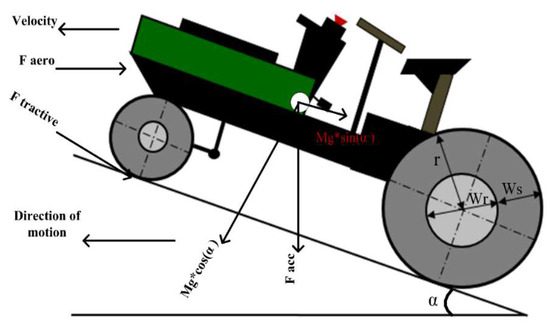
Figure 1.
Representation of dynamic forces’ action on an electric tractor.
3.1.1. Rolling Resistance Force
During the rotation of the vehicle’s tires, a certain section of each tire experiences a continual downward compression at the bottom and then returns to its original position upon exiting the contact area. The energy consumption of the vehicle’s tires is influenced by both the depressing and releasing operations. The energy expended by the tires is commonly known as rolling resistance, which acts as a counterforce to the forward movement of the vehicle. The phenomenon of rolling resistance can be mathematically represented as a normal force that exhibits a direct proportionality to the weight of the vehicle. The rolling resistance force is commonly calculated by Equation (1) [44,45].
3.1.2. Aero Dynamic Drag Force
The aerodynamic drag force arises from the friction between the vehicle’s body and the surrounding air, which is influenced by the speed of the vehicle and the speed of the wind. The drag force is mathematically represented as stated in Equation (2) [44,45].
3.1.3. Gradient Force
The gradient force refers to the component of the tractive force necessary for propelling a vehicle along an inclined surface defined by an angle. This force is generated by the gravitational pull on the vehicle’s mass when it ascends or descends a hill. The expression for the slope force is given by Equation (3) [44,45].
3.1.4. Acceleration Force
Acceleration is required to counteract the forces of inertia resulting from the mass of the vehicle in order to propel the vehicle. The expression for acceleration force is expressed by Equation (4) [44,45].
3.1.5. Drawbar Force
The preliminary application of an ET is to pull the agriculture equipment to plough the land used for seedbed preparation and cultivation. The ability to pull a variety of tillage instruments and some sowing implements at shallow depths requires draft force, which is designated as and mathematically expressed using Equation (5). It is dependent on the width of the agricultural tool and the speed at which it is propelled. When utilizing a tillage implement at deeper depths, the draft is further influenced by the soil texture, depth, and the farming tool shape. The American Society of Agricultural and Biological Engineers’ (ASABE) guidelines were used to determine the draft force [46].
where
- Fi = soil texture adjustment parameter (dimensionless);
- i = 1 for fine, 2 for medium, and 3 for coarse-textured soils (dimensionless);
- A, B, and C = machine-specific parameters (dimensionless);
- V = field speed (km h−1);
- W = machine width (m or number of rows or tools);
- T = tillage depth (cm) for major tools or 1 (dimensionless) for minor tillage tools and seeding implements.
Table 1 displays the exemplary values assigned to the variables in Equation (5).

Table 1.
Parameters of farming implements (ASABE) [46].
3.1.6. Total Tractive Effort
The aggregate tractive force refers to the force generated by the traction motor transmitted to the wheels via a gearbox and transmission system, enabling the vehicle to initiate motion. The sum of rolling resistance, gradient, aerodynamic drag, acceleration and drawbar forces can be observed in Figure 2. The tractive force can be expressed as [45].
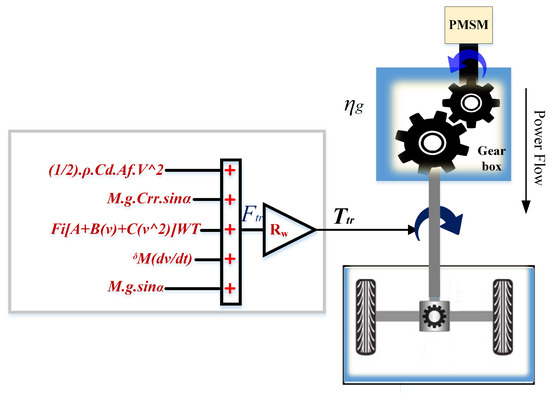
Figure 2.
Representation of dynamic forces’ action on an electric tractor.
Unlike electric vehicles, in ET torque and power requirements which determine the ratings of the driving motor are very crucial when operating at extreme speeds and acceleration times. From Figure 2, it can be observed that by substituting Equations (1)–(5) in Equation (6), the total tractive force at the wheels of the tractor is expressed by Equation (7).
Equation (7) gives the total tractive force required when the tractor is working on the farmland. Sometimes, a trailer with a load is attached to the tractor and the tractor will pull it, during which time, the draft force will become zero and the trailer will have rolling resistance and gradient forces. By combining tractor–trailer resistive forces, the total tractive force is expressed as shown in Equation (8).
The acceleration force given in the equation is linear acceleration. A tractor has many rotating parts such as a motor and gearbox, which have certain inertial values. To consider the effect of those inertial values, linear acceleration is transformed into rotational acceleration by considering the transmission system, gearbox ratio and inertia [47]. With the rotational acceleration, the total tractive force is given by Equation (9).
where J denotes the transmission system’s inertia. The product of tractive force and driving wheel radius is instantaneous torque at the tractor wheel
In ET, the torque is transferred to the wheels by an electric motor via a transmission system (fixed gear), as shown in Figure 2. The electromagnetic torque at the motor shaft is defined in (11).
With the necessary acceleration, the load torque at the motor shaft is provided for the input drive cycle as
In Equation (14), the velocity v is replaced with because the velocity v is in kmph and it is converted into rad/sec.
The above equation gives the total amount of load torque required to operate the tractor in field operations as well as transport applications. In addition, the same is verified with the PMSM by a conduction load test with a DC dynamometer.
3.2. Mathematical Modelling of PMSM
The three-phase system mathematical model is rarely used in control design. This method is known as the time-varying model. Consequently, developing a control strategy becomes significantly more difficult. As a result, a two-phase motor model with a quadrature and direct axes is used in this research. The permanent magnet synchronous motor mathematical model typically includes stator flux equations, voltage equations, mechanical equations, and electromagnetic torque equations, as shown in Equations (15)–(22). The stator voltages of the PMSM are as follows in the d-q reference frame [48,49,50,51]:
Flux linkages are
Substituting these equations into the above equation,
Electromagnetic torque produced is
where is the voltage of the d and q axes, is the current of the d and q axes, is the the inductance of the d and q axes, is the electrical angular velocity, is the inductance of the d and q axes, and Rs is the stator resistance.
The equivalent circuit of PMSM in the d-q model is given in Figure 3a. Vd is the d-axis voltage, and voltage drop caused by stator resistance is denoted by Rs. Ld is the d-axis inductance, which will contribute the d-axis flux linkages. The term indicates the mutual flux linkages of the d-axis caused by the q-axis. Similarly the q-axis’ equivalent circuit is also derived. In the q-axis, an extra term is added due to the flux linkages caused by the permanent magnets. Figure 3b depicts the equivalent circuit of the PMSM in the d-q frame and the mathematical block diagram of the PMSM, respectively.
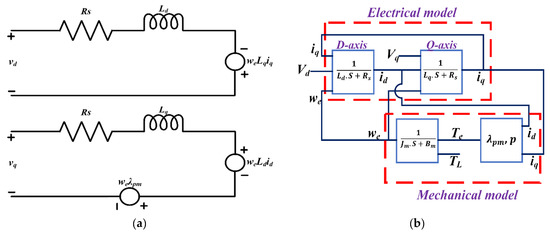
Figure 3.
Electrical equivalent circuit of PMSM model (a), block diagram of mathematical model of PMSM (b).
3.3. Working Condtions and Loadprofile Modelling
To understand the power and torque requirements during the field operations of an electric tractor, two different field conditions were selected. One field condition was selected in such a way that ET performs continuous transfer from one farmland to another farmland. Another field condition was selected for deep loosening operations of soil. Figure 4 gives an idea of how the field conditions were selected. As shown in the figure, the distance between the farmlands for transfer operation was selected as 500 m. Each farm has a length of 658.5 m and width of 28, 39, 56 and 56 m, respectively, and the turning distance at one side is set to 10.5 m. The total turning distances were 105 m, 157.5 m, 220.5 m and 220.5 m, respectively, for farms 1, 2, 3 and 4 [48].

Figure 4.
Field track diagram of electric tractor.
Figure 5 depicts the time–velocity plot for the continuous transfer operation, which incorporates the ET operation (ploughing) in three farms and their respective transfer procedures. While working in farmlands, the operating velocity of ET is 5 kmph, while the continuous transfer operating velocity is 15 kmph. While ploughing, an ET accelerates from 0 kmph to 5 kmph and continues with the same velocity until it reaches the other end of the farm. While turning, the ET reduces the operating velocity, covers a distance of 10.5 m, and again starts to accelerate and runs with continuous velocity until the ploughing of the farmland is completed. Once ploughing is completed, the ET starts accelerating from 0 kmph to 15 kmph, runs with the same velocity, and completes the transfer operation. Again, the same ploughing operation starts in the farmland until it is completed. After entering farmland 4, the ET changes the operating velocity to 6 kmph and performs the deep soil loosening operation. The same acceleration and constant running and deceleration operation continues in the deep soil loosening operation. Figure 5 clearly explains this scenario.

Figure 5.
Tractor velocity vs. time for ploughing operation of farmlands.
For the dynamic modelling of an ET and sizing of the electric motor, the aforementioned velocity profile is used as an input. By using the dynamic equations mentioned in the previous sections and the aforementioned velocity profile, the torque and power requirements of the ET are plotted in Figure 6 and Figure 7. Along with the machine parameters mentioned in Table 1, tillage depths of 20 cm and 30 cm, respectively, are considered as inputs for ploughing and deep soil loosening operations, respectively. From Figure 6 and Figure 7, it can be clearly observed that torque and power profiles of an ET are not constant and they vary based on the velocity profile. To select the continuous power rating and torque capacity, RMS values of torque and power are derived, which are shown in Figure 6 and Figure 7. The desired values of torque and power required are selected from the RMS torque and power, and they are 75 Nm and 24 kW, respectively. The parameters of the electric motor selected for the ET drive train are listed in Table 2 [48].
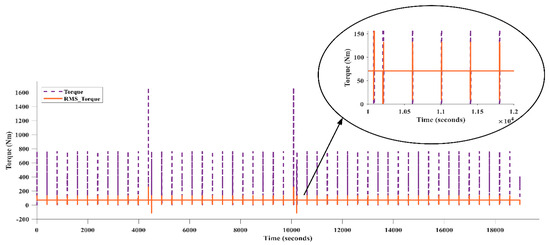
Figure 6.
Torque requirement of electric tractor for ploughing application.
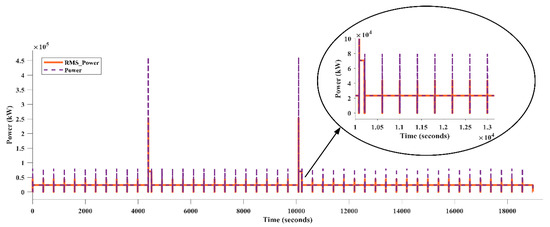
Figure 7.
Power requirement of electric tractor for ploughing application.

Table 2.
Details of traction motor (PMSM).
4. Proposed Methodology
In the context of the electric tractor, the conventional gearbox mode, which consists of a “propulsion motor+ gearbox” system, has been substituted with a low-speed high-torque permanent magnet synchronous motor (PMSM) drive system. The achievement of proper operation of the ET is facilitated by its combination with the converter. Consequently, the current gearbox system is transformed into a low-speed, high-torque permanent magnet synchronous motor (PMSM) that directly propels the electric tractor (ET) via the coupling mechanism. Figure 8 illustrates the structural diagram of the permanent magnet synchronous motor (PMSM) drive system of the electric tractor (ET) and load simulation.
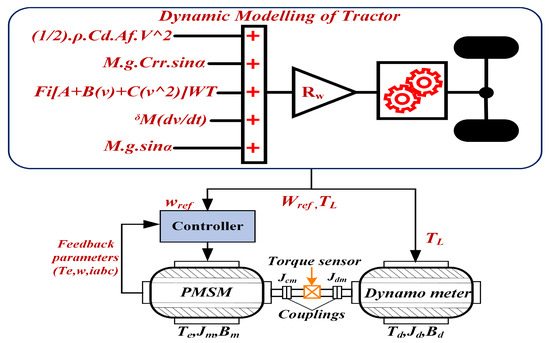
Figure 8.
Schematic for load characteristics validation of PMSM traction drive system for electric tractor application.
This study used a dynamometer to replicate the dynamic behaviour of the electric tractor. The analogue point refers to the point of convergence between the dynamometer and the permanent magnet synchronous motor (PMSM). The dynamometer applies a load to the permanent magnet synchronous motor (PMSM) in the form of torque, and replicates this load by controlling the torque exerted on the motor. Figure 8 displays the structural diagram of the small-scale dynamic load modelling system.
The PMSM and dynamometer are connected back-to-back and mechanically coupled. Since both are coupled mechanically, the dynamometer acts as a load to the PMSM. In this back-to-back connection, the PMSM acts as a test machine and the dynamometer acts as a load machine. With this kind of arrangement, the traction motor of a tractor can be tested with different load variations. When the load machine exerts torque, which is opposite to the traction motor torque emulating the dynamic load of an ET during its traction stage, PMSM runs according to the speed reference generated by the tractor dynamic model, and the dynamometer provides the load variations.
4.1. Tractor Load Simulation Using Dynamometer
From the steady state torque equation of PMSM, we can obtain
From Figure 4, the final equation of load simulation of the tractor system can be written as
To fulfil the objective of the load simulation, the following condition must be satisfied:
Here, is the torque of the dynamometer, are the moment of inertia of the motor coupling, dynamometer coupling and dynamometer, respectively. is the friction coefficient of the dynamometer. From the above equation, the load torque control of the PMSM drive of the ET can be achieved by varying the output torque of the dynamometer with the help of simulation. In the simulation, the load torque of the PMSM could be the sum of the inertia of the coupling 1 and the torque measured by the sensor, which is given by
From the above two equations
By using all the mathematical equations, the simulation model has been developed, which is shown in Figure 9 [49].
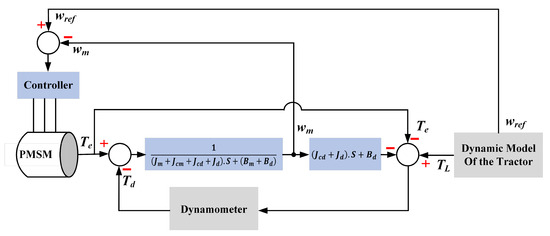
Figure 9.
Illustration of tractor dynamic load simulation using PMSM and dynamometer.
4.2. Control of Traction and Load Motors
The traction motor of an ET is controlled using the classic field-oriented control, which uses a decoupled algorithm to separate torque and flux-producing components so that it can be easily controlled like in DC motor control [50,51]. Figure 10 shows the block diagram for FOC. To implement FOC, the three-phase stator currents of the PMSM are measured and converted into two-phase quantities using the Clarke transformation. Furthermore, the time-variant two-phase quantities are now converted into two-phase time-invariant currents using Park transformation. These two currents represent the torque component and the flux components of PMSM. These are compared with the reference quantities of torque and flux and fed to the PI controller input. The outputs of the PI controllers are Vdref and Vqref, and they are applied to the inverse Park transformation block. The outputs of this projection are Vαref and Vβref. They are fed to the space vector pulse width modulation (SVPWM) algorithm block. The outputs of this block provide signals that drive the inverter. Here, both Park and inverse Park transformations need the rotor flux position.
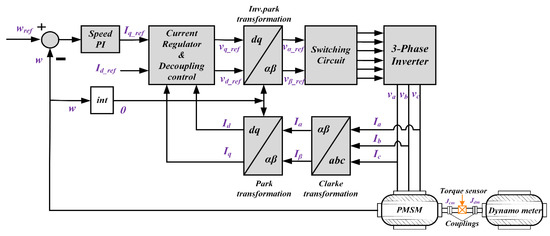
Figure 10.
Block diagram of closed-loop speed control of PMSM.
FOC generates the voltage reference vectors such that a pulse width modulation (PWM) controls the three-phase voltage source inverter (VSI) [52]. The only difference is the traction machine, which operates in speed control mode, and the load machine, which operates in torque control mode. The load motor receives the torque reference from the ET model. The reference value of the torque component (iq_ref) is generated from the load torque (TL). By default, the reference value of the flux component (id_ref) is set to zero since the rotor is a permanent magnet. Different values of load torque generate different values of iq_ref, and the same is compared with the actual measured values. The tractor dynamic model generates the reference (wref) speed value at which the traction motor has to operate. Wref is compared with the actual measured value of speed (w), and the error is fed to the controller to generate a reference value for the current.
4.3. Decoupling of Torque and Flux Components
Decoupling of the torque and flux components makes the design of current controllers easier. From the dynamic modelling of PMSM, it is observed that stator voltage, vd has its influence on both stator currents id and iq. Similarly, the stator voltage vq also affects both id and iq. This d-q axes coupling, called cross-coupling, can also be seen in the torque and flux components. This coupling will not allow control of the speed and torque separately without each component affecting the other. For this, separation of the d-q components is required, which is called decoupling. Figure 11 shows the decoupling arrangement of the d-q components. Independent control of id and iq consists of two PI controllers with a decoupling network like any vector control strategy.

Figure 11.
Current decoupling model of PMSM.
5. HIL Implementation
The phrase hardware-in-the-loop (HIL) refers to the process of testing a vehicle’s hardware by integrating it into a software environment and simulating different real-life scenarios for the hardware to react to. A vehicle’s components and subsystems interact with each other cooperatively, so that the functionality of the smaller components will affect how the entire vehicle operates. The overall purpose of HIL testing is to verify and validate that automotive products are operating as intended. This process helps to accelerate product development and reduce any potential expenses from errors or hardware damages. Figure 12a shows the block diagram of HIL.
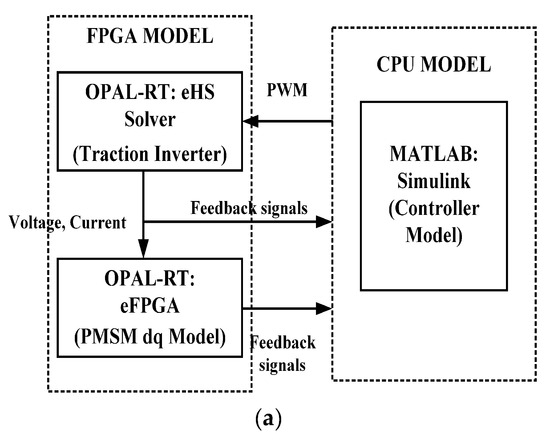
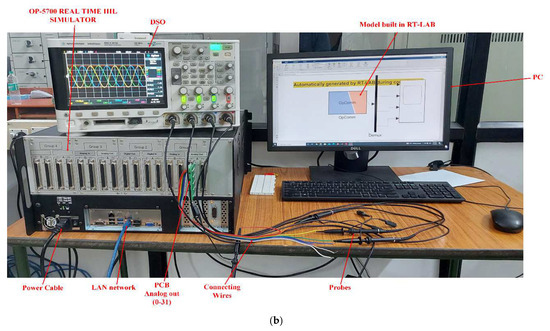
Figure 12.
(a) HIL block diagram. (b) HIL configuration.
The programmable control board (PCB-E06-0560), RT-LAB, MSOx3014T, and probes are used to verify the suggested model of PMSM load characteristics for electric tractor applications. Using analogue outputs and digital inputs, the PCB serves as the communication channel between the simulation and the actual controller. Figure 12b shows the configuration for the real-time implementation setup. Before executing the prototyping tests, engineering systems are typically simulated in real time using HIL systems. Prototypes can be quickly created and synced using stacks. In OPAL-RT, the plant and controller are installed so that the system can run at real-time clock speeds. Due to the fast nanosecond to microsecond OPAL-RT sampling rate, this technique can be regarded as a real-time system simulation. The commands for the RT-digital LAB simulator are run on the user’s PC. The prototype is edited, built, loaded, and run using RT-LAB.
6. Results and Discussion
Generally, an electric motor’s performance is judged by its ability to produce the required speed and torque under different circumstances, such as (1) variable speed and constant torque, (2) constant speed and variable torque, and (3) variable speed and variable torque. When a motor is used in ET applications, the above-mentioned torque and speed profiles are modified as per the driving cycle requirements, which are known as load profile characteristics. In this paper, the performance of PMSM with its load characters is tested with the dynamometer under different load profiles used in ET applications. The dynamometer is used as the load, as mentioned in Section 2. In this paper the load profiles are derived based on the ploughing and soil loosening operation of an ET in the farmlands mentioned in Figure 7.
From the field track, it is observed that the tractor starts from one end, accelerates to the required field velocity and then continues the ploughing operation. Once the tractor reaches the other end of the field, it will take a turn and again continue the ploughing at its rated velocity. This will complete one trip in the field. It will take several trips for an ET to plough the complete field. Sometimes, during the land levelling and front-end loader applications, the tractor is required to reverse at a reduced speed and partial load. This operation requires the tractor to move forward and then reverse. In order to assess the performance of the PMSM used in an ET, the aforementioned load profiles are used in three cases.
The traction motor is operated by soft starting by slowly increasing the speed from zero to its rated value of 250 rad/s; at the same time, the traction motor has 60 Nm of torque. After reaching the rated speed, the torque is increased to its rated value of 100 Nm. After 1 s, the speed suddenly drops to 150 rad/s and remains constant; torque remains the same at 100 Nm until 1.5 s, when it drops to 75 Nm. The input torque and the speed profile of the traction motor are shown in Figure 13a,d, respectively.
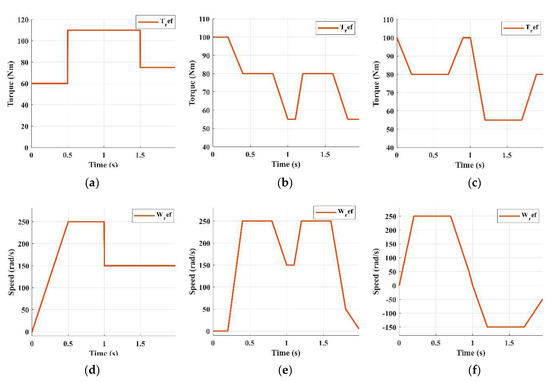
Figure 13.
(a–c) Reference torque profiles of an electric tractor for ploughing application. (d–f) Reference speed profiles for the corresponding torque profiles given in (a–c).
In the second case, the torque and speed profiles of the traction motor are provided by considering the application of the ET in the field only in the forward direction to plough the field using the field track given in Section 4.3. Initially, the traction motor has zero speed and 100 Nm torque at 0 s. It starts accelerating after 0.2 s and reaches 250 rad/s; at the same time, the torque drops to 80 Nm and remains the same until 0.8 s, and reaches 55 Nm at 1 s. Similarly, the speed also reduces from 205 rad/s to 150 rad/s. After 1.05 s, the motor starts to accelerate again to 250 rad/s and 80 Nm of torque and continues until 1.6 s. After that, the traction motor speed drops to zero. The respective torque and speed profiles are shown in Figure 13b,e.
In the third scenario, the torque and speed profiles of the traction motor are similar to the second one, but it replicates the operation of the ET in the reverse direction, so the speed profile also changes from a positive value to a negative value at time 1 s to illustrate the backward running operation of the ET. The motor starts accelerating from zero to 250 rad/s; at the same time, the torque starts to decrease from 100 nm to 80 nm. At 1 s, the speed starts decreasing from 250 rad/s to zero and from zero to −150 rad/s at time 1.5 s, then remains constant. Similarly, the torque also varies. The respective torque and speed profiles are shown in Figure 13c,f.
6.1. Case 1
The tractor starts accelerating and reaches its operating velocity at t = 0.5 s. After that, it will maintain the same velocity (250 rad/s) until t = 1 s and drop instantly to 150 rad/s. The torque requirement during acceleration is 60 Nm. At t = 0.5 s, it increases to 110 Nm and remains the same until t = 1.5 s. Then, it drops instantly to 75 Nm and continues with the same torque until t = 2 s. Figure 14a–c show the Matlab (v2021a) results of electromagnetic torque (Tem), operating speed (wm) and d-q axis currents for the PMSM traction motor. During the time t = 0 to 0.5 s, the PMSM produces a slight variation in Tem. After that, Tem follows the reference torque (Tref). At time t = 1 s, there is a sudden dip in the torque for a short duration due to the change in speed. The accelerating torque (Tacc) exists only when there is a difference in the Tem and Tref. If the Tem is greater than Tref, then Tacc is negative, and if Tem is less than Tem, then Tacc is positive. This is clearly observed in Figure 14a. Similarly, Figure 14b shows the speed response of the PMSM. The motor operating speed (wm) always follows the reference speed (wref). Whenever there is a change in wref, there is a slight change (either a rise or fall) in wm. The response of the d-q axis currents is shown in Figure 14c. The d-axis current is always maintained at zero and the q-axis current follows the torque profile. The HIL results of the Tem, wm, and d-q axis currents of the PMSM are also shown in Figure 15a–c, respectively.
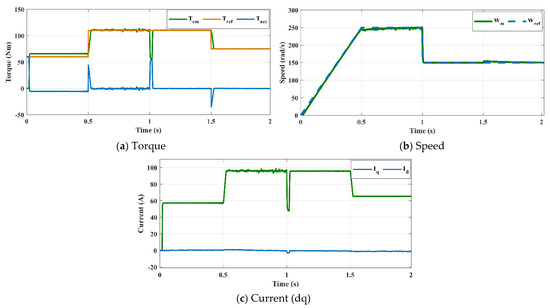
Figure 14.
Simulation results of (a) torque, (b) speed, and (c) current (dq) for case 1.
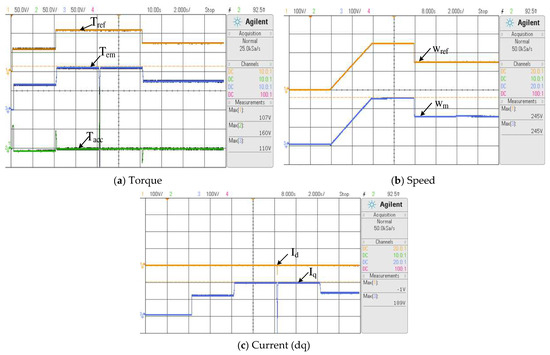
Figure 15.
HIL results of (a) torque, (b) speed, and (c) current (dq) for case 1.
6.2. Case 2
In case 2, the tractor operates in the field for a ploughing operation for one complete trip. The tractor starts with zero velocity and maximum torque (100 Nm). At t = 0.2 s, it starts accelerating, and at t = 0.4 s, it reaches its rated velocity and continues to plough the field, operating at 80 Nm. At t = 0.8 s, it reaches the other end of the field and starts decelerating to take the turn, and torque also reduces to 55 Nm. At t = 1.05 s, it starts accelerating again, and after reaching its rated velocity at t = 1.5 s, it continues to plough the field at an operating torque of 80 Nm. After completing one trip, the speed reduces to zero. Figure 16a–c show the MATLAB (v2021a) results of Tem, wm and d-q axis currents for the PMSM. In Figure 16a, from t = 0.2 s to t = 0.4 s, Tacc exists and it is positive since Tem is higher than the Tref. Similarly, when there is a change in the Tref, Tacc exists since Tem undergoes a slight delay in following the Tref. Figure 16b shows the speed response of the PMSM. The motor speed (wm) always follows the wref. The response of the d-q axis currents is shown in Figure 16c. The d-axis current is always maintained at zero and the q-axis current follows the torque profile. The HIL results of the Tem, wm, d-q axis currents of the PMSM are also shown in Figure 17a–c, respectively, for the tractor ploughing operation in the field.
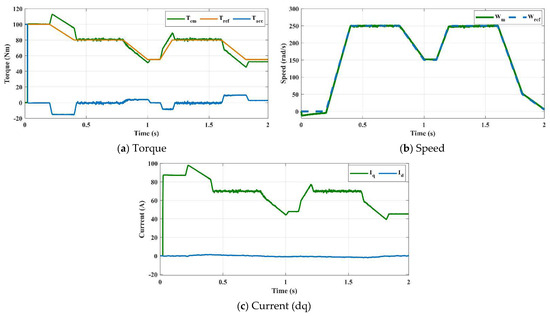
Figure 16.
Simulation results of (a) torque, (b) speed, and (c) current (dq) for case 2.
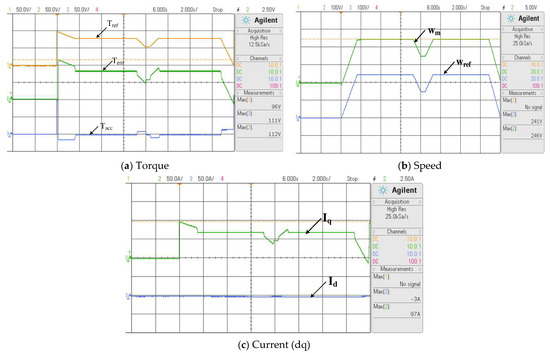
Figure 17.
HIL results of (a) torque, (b) speed, and (c) current (dq) for case 2.
6.3. Case 3
In case 3, the tractor operates on the front loader for land levelling and seedbed preparation applications. The tractor starts with constant acceleration and, similarly, the torque also starts decreasing from its maximum value (100 Nm). At t = 0.2 s, the tractor reaches its rated speed and the torque is 80 Nm. At t = 0.7 s, the tractor speed starts decreasing to a negative value, and at the same time, the torque starts increasing and reaches 100 Nm at t = 0.95 s, where it is maintained until t = 1 s; at the same time, the speed is 0 rad/s. From 0 rad/s speed, it starts accelerating in the reverse direction and reaches the value of −150 rad/s at t = 1.2 s, while the torque starts decreasing and reaches 55 Nm. The tractor continues to operate in the reverse direction with a partial load of 55 Nm acting on it. At t = 1.8 s, the tractor’s speed starts decreasing to 0 rad/s and the torque increases to 80 Nm. Figure 18a–c show the MATLAB results of Tem, wm and d-q axis currents for the PMSM. In Figure 18a, until t = 0.2 s, Tacc exists and it is negative since Tem is higher than the Tref. Similarly, when there is a change in the Tref, Tacc exists since Tem undergoes a slight delay in following the Tref. From t = 0.7 s to t = 1.2 s, Tem is unable to produce the Tref since both speed and torque are changing at the same intervals. Figure 18b gives the speed response of the PMSM. From t = 0.7 s to t = 1.2 s, the speed changes from positive to negative as the tractor moves in the reverse direction, and again at t = 2 s, the speed reaches zero, which shows that the tractor is in a standstill position. During the reverse operation of the tractor, it operates with a partial load. The d-q axis currents of the PMSM are shown in Figure 18c. The HIL results of the Tem, wm, d-q axis currents of the PMSM are also shown in Figure 19a–c, respectively, for the tractor operation in the field operating in both forward and reverse directions for land levelling and seedbed preparation applications.
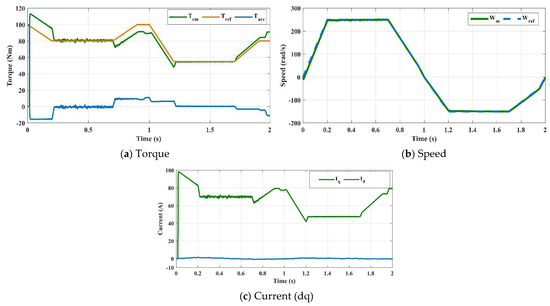
Figure 18.
Simulation results of (a) torque, (b) speed, and (c) current (dq) for case 3.
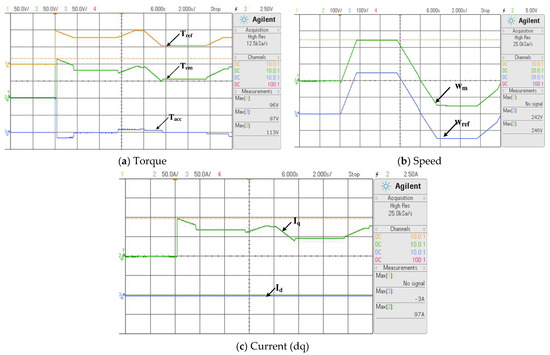
Figure 19.
HIL results of (a) torque, (b) speed, and (c) current (dq) for case 3.
The simulation and the HIL results show the proposed load-tracking algorithm works accurately. Table 3 gives a brief comparison of the proposed algorithm with the existing literature. Whenever there is a change in the reference speed, the actual measured speed produces an overshoot of 3.5% and it settles at 0.01 s, whereas that of Refs. [52,53] produces an overshoot of 15% and 6.3%, respectively. Similarly, the proposed method produces a torque overshoot of 25% of the reference torque and it settles 0.025 s. Compared to Refs. [43,53], the torque overshoot (13% and 7.8%) is a bit higher. However, this algorithm is applied to off-road electric tractor operations, whereas it has traditionally been applied to on-road electric vehicle operations.

Table 3.
Comparison of the proposed algorithm.
The present study utilizes the load-tracking algorithm to independently control torque and speed, which has been previously employed in other approaches. However, a notable distinction is that this algorithm is applied to off-road electric tractor operations, whereas it has traditionally been used for on-road electric vehicle applications. This novel application is considered to be a significant contribution of the proposed work. Furthermore, this algorithm is designed to efficiently process the driver commands and autonomously respond to them, especially on uneven agricultural terrain. It takes into account a wider range of dynamics that have not been addressed in the existing research. The utilization of this technology effectively reduces the computational complexity, hence optimizing the overall system performance. Hence, the work presented above exhibits novelty in terms of its application, distinguishing it from other traditional works.
7. Conclusions
In view of the difficulty of accurately simulating the load characteristics of an electric tractor, this study presents a novel dynamic load simulation tracking technique. This strategy is developed within the framework of an established load simulation system. The selection of the permanent magnet synchronous motor (PMSM) drive system is based on the dynamic modelling of the electric tractor system. The simulation outcomes of the proposed system exhibit a strong correlation with the trajectory patterns observed in the real-world traction drive of an electric tractor. The effectiveness of modelling the load characteristics of the ET propulsion system is demonstrated with the dynamic load simulation approach that is based on a mathematical model. The findings demonstrate that the load-tracking algorithm and simulation approach employed in this study successfully enable the simulation of load characteristics in the propulsion unit of an electric tractor, specifically the permanent magnet synchronous motor (PMSM) drive.
In conclusion, the aforementioned findings validate the applicability of the proposed load characteristic simulation approach for conducting a comprehensive analysis and evaluation of the static and dynamic properties of the permanent magnet synchronous motor (PMSM) drive system in an electric tractor. Furthermore, the methodology suggested in this research was evaluated in a real-time context using a hardware-in-the-loop (HIL) simulator.
Author Contributions
Conceptualization, R.S.W.; Investigation, C.R.G.; Methodology, C.R.G.; Supervision, R.S.W.; Validation, C.R.G.; Writing—original draft, C.R.G.; Writing—review and editing, R.S.W. All authors have read and agreed to the published version of the manuscript.
Funding
This research received no external funding.
Institutional Review Board Statement
Not applicable.
Informed Consent Statement
Not applicable.
Data Availability Statement
Not applicable.
Conflicts of Interest
The authors declare no conflict of interest.
Nomenclature
| Rolling resistance force | |
| Aerodynamic drag force | |
| Grading resistance force | |
| Acceleration force | |
| Agriculture Implement draft force | |
| F | Soil texture adjustment parameter (dimensionless). For fine textured soil i = 1, 2 for medium and 3 for coarse textured soils. |
| A, B, C | Machine specific parameters |
| V | Operating velocity of tractor |
| W | Machine width or number of rows |
| T | Depth of tillage |
| Mass of the tractor | |
| Gravitational constant | |
| Rolling resistance coefficient | |
| Angle of gradient | |
| Air density | |
| Drag coefficient | |
| Frontal area of the tractor | |
| V | Operating velocity |
| Gross weight of the tractor | |
| Gross weight of the trailer | |
| Moment of inertia of transmission, tractor, motor, motor coupling, dynamometer and its coupling | |
| Wheel radius | |
| Gear ratio | |
| Efficiency of the transmission system | |
| Torque at wheels | |
| Shaft torque | |
| Load torque | |
| Angular velocity | |
| Voltage of d and q axis | |
| Current of d and q axis | |
| Inductance of d and q axis | |
| Electrical angular velocity | |
| Q-axis inductance | |
| Rs | Stator resistance |
| Flux linkages | |
| No of pole pairs | |
| Friction coefficient of motor, dynamometer |
References
- Mehta, C.R.; Chandel, N.S.; Jena, P.C.; Jha, A. Indian agriculture counting on farm mechanization. Agric. Mech. Asia Afr. Lat. Am. 2019, 50, 84–89. [Google Scholar]
- Fiorati, S.; Bernardini, A.; Haley, N. Electric tractor prospective. In Proceedings of the CNH Industrial, 29th Members Meeting, Hannover, Germany, 10–11 November 2019. [Google Scholar]
- Samaranayake, L.; Longo, S. Degradation control for electric vehicle machines using nonlinear model predictive control. IEEE Trans. Control Syst. Technol. 2017, 26, 89–101. [Google Scholar] [CrossRef]
- Lagnelöv, O.; Larsson, G.; Larsolle, A.; Hansson, P.A. Life cycle assessment of autonomous electric field tractors in Swedish agriculture. Sustainability 2021, 13, 11285. [Google Scholar] [CrossRef]
- Biró, N.; Kiss, P. Emission Quantification for Sustainable Heavy-Duty Transportation. Sustainability 2023, 15, 7483. [Google Scholar] [CrossRef]
- Scolaro, E.; Alberti, L.; Barater, D. Electric Drives for Hybrid Electric Agricultural Tractors. In Proceedings of the 2021 IEEE Workshop on Electrical Machines Design, Control and Diagnosis (WEMDCD), Modena, Italy, 8–9 April 2021. [Google Scholar]
- Kahveci, H.; Okumuş, H.I.; Ekici, M. Improved brushless DC motor speed controller with digital signal processor. Electron. Lett. 2014, 50, 864–866. [Google Scholar] [CrossRef]
- Amezquita-Brooks, L.; Liceaga-Castro, J.; Liceaga-Castro, E. Speed and position controllers using indirect field-oriented control:A classical control approach. IEEE Trans. Ind. Electron. 2013, 61, 1928–1943. [Google Scholar] [CrossRef]
- Kiran, K.; Das, S.; Singh, D. Model predictive field oriented speed control of brushless doubly-fed reluctance motor drive. In Proceedings of the International Conference on Power, Instrumentation, Control and Computing (PICC), Thrissur, India, 18–20 January 2018; pp. 1–6. [Google Scholar]
- Liu, T.; Chen, G.; Li, S. Application of Vector Control Technology for PMSM Used in Electric Vehicles. Open Autom. Control Syst. J. 2014, 6, 1334–1341. [Google Scholar] [CrossRef]
- Niu, L.; Yang, M.; Gui, X.; Xu, D. A comparative study of model predictive current control and FOC for PMSM. In Proceedings of the 17th International Conference on Electrical Machines and Systems (ICEMS), Hangzhou, China, 22 October 2014; pp. 3143–3147. [Google Scholar]
- Niu, F.; Wang, B.; Babel, A.S.; Li, K.; Strangas, E.G. Comparative evaluation of direct torque control strategies for permanent magnet synchronous machines. IEEE Trans. Power Electron. 2015, 31, 1408–1424. [Google Scholar] [CrossRef]
- Liu, X.; Chen, H.; Zhao, J.; Belahcen, A. Research on the performances and parameters of interior PMSM used for electric vehicles. IEEE Trans. Ind. Electron. 2016, 63, 3533–3545. [Google Scholar] [CrossRef]
- Wu, S.; Zhang, J. A robust adaptive control for permanent magnet synchronous motor subject to parameter uncertainties and input saturations. J. Electr. Eng. Technol. 2018, 13, 2125–2133. [Google Scholar]
- Lajunen, A.; Sainio, P.; Laurila, L.; Pippuri-Mäkeläinen, J.; Tammi, K. Overview of powertrain electrification and future scenarios for non-road mobile machinery. Energies 2018, 11, 1184. [Google Scholar] [CrossRef]
- Florentsev, S.; Izosimov, D.; Makarov, L.; Baida, S.; Belousov, A. Complete traction electric equipment sets of electro-mechanical drive trains for tractors. In Proceedings of the 2010 IEEE Region 8 International Conference on Computational Technologies in Electrical and Electronics Engineering (SIBIRCON), Irkutsk, Russia, 11–15 July 2010; pp. 611–616. [Google Scholar] [CrossRef]
- Troncon, D.; Alberti, L.; Mattetti, M. A Feasibility Study for Agriculture Tractors Electrification: Duty Cycles Simulation and Consumption Comparison. In Proceedings of the 2019 IEEE Transportation Electrification Conference and Expo (ITEC), Detroit, MI, USA, 19–21 June 2019. [Google Scholar] [CrossRef]
- Arjharn, W.; Koike, M.; Takigawa, T.; Yoda, A.; Hasegawa, H.; Bahalayodhin, B. Preliminary Study on the Applicability of an Electric Tractor (Part 1): Energy Consumption and Drawbar Pull Performance. J. Jpn. Soc. Agric. Mach. 2001, 63, 130–137. [Google Scholar] [CrossRef]
- Arjharn, W.; Koike, M.; Takigawa, T.; Yoda, A.; Hasegawa, H.; Bahalayodhin, B. Preliminary study on the applicability of an electric tractor (part 2). J. Jpn. Soc. Agric. Mach. 2001, 63, 92–99. [Google Scholar]
- Troncon, D.; Alberti, L. Case of study of the electrification of a tractor: Electric motor performance requirements and design. Energies 2020, 13, 2197. [Google Scholar] [CrossRef]
- Baek, S.M.; Kim, W.S.; Park, S.U.; Kim, Y.J. Analysis of Equivalent Torque of 78 kW Agricultural Tractor during Rotary Tillage. J. Korea Inst. Inf. Electron. Commun. Technol. 2019, 12, 359–365. [Google Scholar]
- Lee, D.H.; Kim, Y.J.; Choi, C.H.; Chung, S.O.; Inoue, E.; Okayasu, T. Development of a parallel hybrid system for agricultural tractors. J. Fac. Agric. Kyushu Univ. 2017, 62, 137–144. [Google Scholar] [CrossRef] [PubMed]
- Brenna, M.; Foiadelli, F.; Leone, C.; Longo, M.; Zaninelli, D. Feasibility Proposal for Heavy Duty Farm Tractor. In Proceedings of the 2018 International Conference of Electrical and Electronic Technologies for Automotive, Milan, Italy, 9–11 July 2018; pp. 1–6. [Google Scholar] [CrossRef]
- Das, A.; Jain, Y.; Agrewale, M.R.B.; Bhateshvar, Y.K.; Vora, K. Design of a Concept Electric Mini Tractor. In Proceedings of the 2019 IEEE Transportation Electrification Conference, ITEC-India, Bengaluru, India, 17–19 December 2019; pp. 10–14. [Google Scholar] [CrossRef]
- Mousazadeh, H.; Keyhani, A.; Javadi, A.; Mobli, H.; Abrinia, K.; Sharifi, A. Life-cycle assessment of a Solar Assist Plug-in Hybrid electric Tractor (SAPHT) in comparison with a conventional tractor. Energy Convers. Manag. 2011, 52, 1700–1710. [Google Scholar] [CrossRef]
- Ueka, Y.; Yamashita, J.; Sato, K.; Doi, Y. Study on the development of the electric tractor-Specifications and traveling and tilling performance of a prototype electric tractor. Eng. Agric. Environ. Food 2013, 6, 160–164. [Google Scholar] [CrossRef]
- Troncon, D.; Alberti, L.; Bolognani, S.; Bettella, F.; Gatto, A. Electrification of agricultural machinery: A feasibility evaluation. In Proceedings of the 2019 Fourteenth International Conference on Ecological Vehicles and Renewable Energies (EVER), Monte-Carlo, Monaco, 8–10 May 2019; pp. 1–7. [Google Scholar] [CrossRef]
- Matache, M.G.; Cristea, M.; Găgeanu, I.; Zapciu, A.; Tudor, E.; Carpus, E.; Popa, L.D. Small power electric tractor performance during ploughing works. Inmateh-Agric. Eng. 2020, 60, 123–128. [Google Scholar] [CrossRef]
- Yoo, I.; Lee, T.; Kim, B.; Hur, J.; Yeon, K.; Kim, G. Performance interpretation method for electrical tractor based on model-based design. In Proceedings of the 2013 International Conference on IT Convergence and Security (ICITCS), Macao, China, 16–18 December 2013; pp. 1–4. [Google Scholar] [CrossRef]
- Moreda, G.P.; Muñoz-García, M.A.; Barreiro, P. High voltage electrification of tractor and agricultural machinery—A review. Energy Convers. Manag. 2016, 115, 117–131. [Google Scholar] [CrossRef]
- Riedner, L.; Mair, C.; Zimek, M.; Brudermann, T.; Stern, T. E-mobility in agriculture: Differences in perception between experienced and non-experienced electric vehicle users. Clean Technol. Environ. Policy 2019, 21, 55–67. [Google Scholar] [CrossRef]
- Baek, S.Y.; Kim, Y.S.; Kim, W.S.; Baek, S.M.; Kim, Y.J. Development and verification of a simulation model for 120 kW class electric AWD (all-wheel-drive) tractor during driving operation. Energies 2020, 13, 2422. [Google Scholar] [CrossRef]
- Rajalakshmi, M.; Razia Sultana, W. Intelligent Hybrid Battery Management System for Electric Vehicle. In Artificial Intelligent Techniques for Electric and Hybrid Electric Vehicles; Wiley: Hoboken, NJ, USA, 2020; pp. 179–206. [Google Scholar]
- Xu, L.-Y.; Xia, X.-W.; Zhou, Z.-L.; Liu, H.-L.; Wei, M.-L. Simulation and analysis for driving system of electric tractor based on CRUISE. In Design, Manufacturing and Mechatronics, Proceedings of the 2015 International Conference on Design, Manufacturing and Mechatronics (ICDMM2015), Wuhan, China, 17–18 April 2015; World Scientific: Singapore, 2015; pp. 1367–1375. [Google Scholar] [CrossRef]
- Li, G.; Hu, J.; Li, Y.; Zhu, J. An Improved Model Predictive Direct Torque Control Strategy for Reducing Harmonic Currents and Torque Ripples of Five-Phase Permanent Magnet Synchronous Motors. IEEE Trans. Ind. Electron. 2019, 66, 5820–5829. [Google Scholar] [CrossRef]
- Morales-Caporal, R.; Leal-Lopez, M.E.; de Jesus Rangel-Magdaleno, J.; Sandre-Hernandez, O.; Cruz-Vega, I. Direct Torque Control of a PMSM-Drive for Electric Vehicle Applications. In Proceedings of the 2018 International Conference on Electronics, Communications and Computers (CONIELECOMP), Cholula, Mexico, 21–23 February 2018; Volume 2018, pp. 232–237. [Google Scholar]
- Shinohara, A.; Inoue, Y.; Morimoto, S.; Sanada, M. Maximum Torque Per Ampere Control in Stator Flux Linkage Synchronous Frame for DTC-Based PMSM Drives without Using q-Axis Inductance. IEEE Trans. Ind. Appl. 2017, 53, 3663–3671. [Google Scholar] [CrossRef]
- Abassi, M.; Khlaief, A.; Saadaoui, O.; Chaari, A.; Boussak, M. Performance Analysis of FOC and DTC for PMSM Drives Using SVPWM Technique. In Proceedings of the 2015 16th International Conference on Sciences and Techniques of Automatic Control and Computer Engineering (STA), Monastir, Tunisia, 21–23 December 2016; pp. 228–233. [Google Scholar]
- Gade, C.R.; Sultana, W.R. Battery Electric Tractor Powertrain Component Sizing with Respect to Energy Consumption, Driving Patterns and Performance Evaluation Using Traction Motor. Distrib. Gener. Altern. Energy J. 2023, 38, 789–816. [Google Scholar] [CrossRef]
- Nagar, H.; Bisaria, S.; Dalei, A.; Reddy, G.C.; Sultana, W.R.; Chitra, A. Powertrain Sizing and Performance Evaluation for Battery Electric Vehicle Using Model Based Design. In Proceedings of the 2021 Innovations in Power and Advanced Computing Technologies (i-PACT), Kuala Lumpur, Malaysia, 27–29 November 2021. [Google Scholar]
- Qin, J.; Du, J. Minimum-learning-parameter-based adaptive finite-time trajectory tracking event-triggered control for underactuated surface vessels with parametric uncertainties. Ocean. Eng. 2023, 271, 113634. [Google Scholar] [CrossRef]
- Qin, J.; Du, J.; Li, J. Adaptive finite-time trajectory tracking event-triggered control scheme for underactuated surface vessels subject to input saturation. IEEE Trans. Intell. Transp. Syst. 2023, 24, 8809–8819. [Google Scholar] [CrossRef]
- Murali, A.; Wahab, R.S.; Gade, C.S.R.; Annamalai, C.; Subramaniam, U. Assessing Finite Control Set Model Predictive Speed Controlled PMSM Performance for Deployment in Electric Vehicles. World Electr. Veh. J. 2021, 12, 41. [Google Scholar] [CrossRef]
- American Society of Agricultural and Biological Engineers. ASAE D497.7 MAR2011 Agricultural Machinery Management Data; American Society of Agricultural and Biological Engineers: St. Joseph, MI, USA, 2011; p. 9. [Google Scholar]
- Gade, C.R.; Wahab, R.S. Control of Permanent Magnet Synchronous Motor Using MPC–MTPA Control for Deployment in Electric Tractor. Sustainability 2022, 14, 12428. [Google Scholar] [CrossRef]
- Saleh, S.A.; Ozkop, E.; Nahid-Mobarakeh, B.; Rubaai, A.; Muttaqi, K.M.; Pradhan, S. Survivability-based protection for three phase permanent magnet synchronous motor drives. In Proceedings of the 2022 IEEE Industry Applications Society Annual Meeting (IAS), Detroit, MI, USA, 9–14 October 2022. [Google Scholar]
- Cendoya, M.; Solsona, J.; Toccaceli, G.; Valla, M.I. Algorithm for rotor position and speed estimation in permanent magnet ac motors. Int. J. Electron. 2002, 89, 717–727. [Google Scholar] [CrossRef]
- Bai, H.; Yu, B.; Gu, W. Research on Position Sensorless Control of RDT Motor Based on Improved SMO with Continuous Hyperbolic Tangent Function and Improved Feedforward PLL. J. Mar. Sci. Eng. 2023, 11, 642. [Google Scholar] [CrossRef]
- Lu, E.; Li, W.; Yang, X.; Liu, Y. Simulation Method of Load Characteristics of High-power PMSM Drive System. J. Phys. Conf. Ser. 2020, 1678, 012077. [Google Scholar] [CrossRef]
- Kozłowski, M.; Czerepicki, A. Quick Electrical Drive Selection Method for Bus Retrofitting. Sustainability 2023, 15, 10484. [Google Scholar] [CrossRef]
- Sultana, W.R.; Sahoo, S.K.; Karthikeyan, S.P.; Reddy, P.V.; Reddy, G.T.R.; Kiran, K.S.; Raglend, I.J. Comparative analysis of model predictive control and PWM control techniques for VSI. In Proceedings of the 2014 International Conference on Control, Instrumentation, Communication and Computational Technologies (ICCICCT), Kanyakumari, India, 10–11 July 2014; pp. 1495–1499. [Google Scholar] [CrossRef]
- Şahin, M.E.; Okumuş, H.İ. Comparison of different controllers and stability analysis for photovoltaic powered buck-boost DC-DC converter. Electr. Power Compon. Syst. 2018, 46, 149–161. [Google Scholar] [CrossRef]
- Dong, C.S.T.; Le, H.H.; Vo, H.H. Field oriented controlled permanent magnet synchronous motor drive for an electric vehicle. Int. J. Power Electron. Drive Syst. (IJPEDS) 2023, 14, 1374–1381. [Google Scholar] [CrossRef]
Disclaimer/Publisher’s Note: The statements, opinions and data contained in all publications are solely those of the individual author(s) and contributor(s) and not of MDPI and/or the editor(s). MDPI and/or the editor(s) disclaim responsibility for any injury to people or property resulting from any ideas, methods, instructions or products referred to in the content. |
© 2023 by the authors. Licensee MDPI, Basel, Switzerland. This article is an open access article distributed under the terms and conditions of the Creative Commons Attribution (CC BY) license (https://creativecommons.org/licenses/by/4.0/).